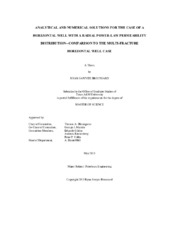| dc.description.abstract | In this work, I present the development of analytical solutions in the Laplace domain for a fully-penetrating, horizontal well producing at a constant flow rate or constant wellbore pressure in the center of a composite, cylindrical reservoir system with an impermeable outer boundary. The composite reservoir consists of two regions. The cylindrical region closest to the wellbore is stimulated, and the permeability within this region follows a power-law function of the radial distance from the wellbore. The unstimulated outer region has homogeneous reservoir properties.
The current norm for successful stimulation of low permeability reservoir rocks is multi-stage hydraulic fracturing. The process of hydraulic fracturing creates thin, high permeability fractures that propagate deep into the reservoir, increasing the area of the rock matrix that is exposed to this low-resistance flow pathway. The large surface area of the high conductivity fracture is what makes hydraulic fracturing so successful. Unfortunately, hydraulic fracturing is often encumbered by problems such as high capital costs and a need for large volumes of water. Therefore, I investigate a new stimulation concept based upon the alteration of the permeability of a large volume around the producing well assembly from its original regime to that following a power-law function. I evaluate the effectiveness of the new concept by comparing it to conventional multi-stage hydraulic fracturing.
The results of this investigation show that the power-law permeability reservoir (PPR) has a performance advantage over the multi-fractured horizontal treatment (MFH) only when the fracture conductivity and fracture half-length are small. Most importantly, the results demonstrate that the PPR can provide respectable flow rates and recovery factors, thus making it a viable stimulation concept for ultra-low permeability reservoirs, especially under conditions that may not be conducive to a conventional MHF treatment. | en |


